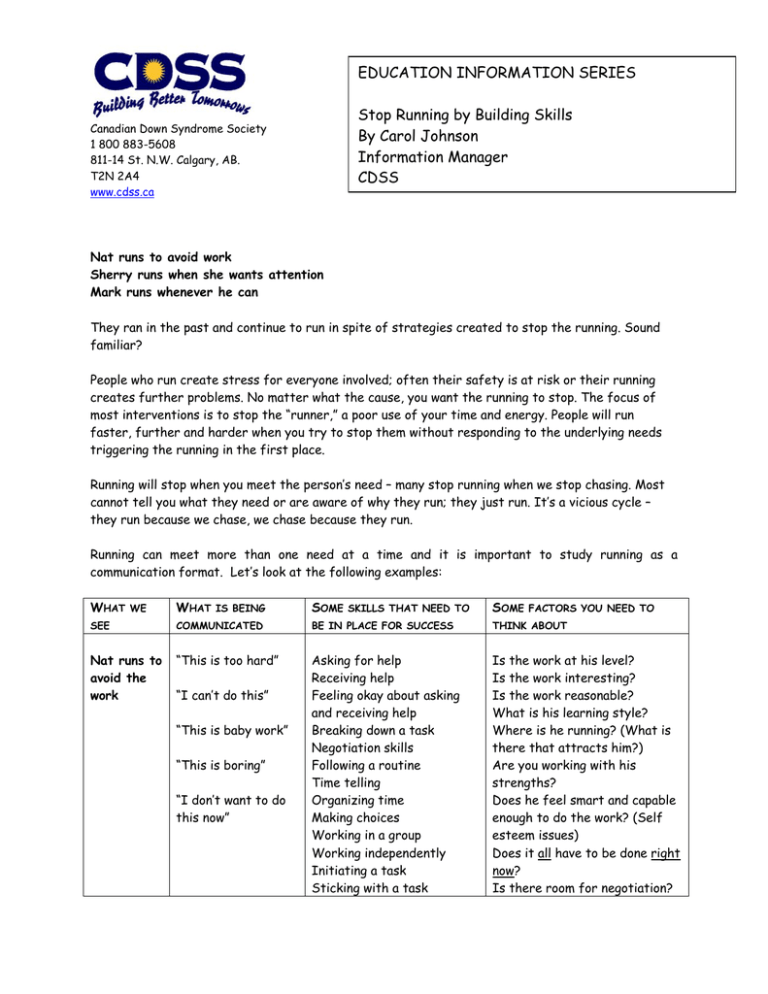Stop Running by Building Skills - The Canadian Down Syndrome
advertisement

EDUCATION INFORMATION SERIES Stop Running by Building Skills By Carol Johnson Information Manager CDSS Canadian Down Syndrome Society 1 800 883-5608 811-14 St. N.W. Calgary, AB. T2N 2A4 www.cdss.ca Nat runs to avoid work Sherry runs when she wants attention Mark runs whenever he can They ran in the past and continue to run in spite of strategies created to stop the running. Sound familiar? People who run create stress for everyone involved; often their safety is at risk or their running creates further problems. No matter what the cause, you want the running to stop. The focus of most interventions is to stop the “runner,” a poor use of your time and energy. People will run faster, further and harder when you try to stop them without responding to the underlying needs triggering the running in the first place. Running will stop when you meet the person’s need – many stop running when we stop chasing. Most cannot tell you what they need or are aware of why they run; they just run. It’s a vicious cycle – they run because we chase, we chase because they run. Running can meet more than one need at a time and it is important to study running as a communication format. Let’s look at the following examples: WHAT WE WHAT IS BEING SOME SKILLS THAT NEED TO SOME FACTORS YOU NEED TO SEE COMMUNICATED BE IN PLACE FOR SUCCESS THINK ABOUT Nat runs to avoid the work “This is too hard” Asking for help Receiving help Feeling okay about asking and receiving help Breaking down a task Negotiation skills Following a routine Time telling Organizing time Making choices Working in a group Working independently Initiating a task Sticking with a task Is the work at his level? Is the work interesting? Is the work reasonable? What is his learning style? Where is he running? (What is there that attracts him?) Are you working with his strengths? Does he feel smart and capable enough to do the work? (Self esteem issues) Does it all have to be done right now? Is there room for negotiation? “I can’t do this” “This is baby work” “This is boring” “I don’t want to do this now” What choices does Nat make in a day? Does Nat understand how the schedule works? Sherry runs to get attention “Look at me” “Catch me if you can” “This is more fun” “I like it when you chase me” “NOW, they are paying attention!” Mark runs whenever he can “I need to get away from here” (Avoidance) “This is fun” (Attention) “I need to get to there” (going to a specific place) Making and keeping friends Play skills (group/indiv.) Social skills Reciprocal communication skills with peers/others. Leadership skills Obtaining positive attention from others Sharing time/activities with others. Turn taking (waiting for attention in a group) Who is paying attention when she is cooperating? How much? Does she have friends in the group? Does she work in isolation some/most of the time? What does she have in common with peers? Who chases her? (this may be a way to have 1:1 with someone she likes) Does she know who she is? Is this her “claim to fame”? Refer to Nat’s information (above) Has Mark learned that it is easier to “take off” than to try to communicate? Does anyone listen to him? Is this his only way to have some control/power? What kinds of choices is he allowed in a day? Is he running away from something? What would that be and how else can he avoid or change that situation? Is he running towards something? What would that be and how else can he obtain his goal? Refer to Sherry’s information (above) Indicating where he wants to go Asking permission to leave Waiting to go (turn taking) Problem solving Making choices Making plans Safety rules Nat runs to avoid work In this example, Nat is running to avoid a situation he feels stressed about. Although the situation may not seem stressful to you, the running indicates that something is not working for Nat. As long as Nat does not feel good about the task and is unable to communicate or change the agenda using words or symbols, he will run. There are a number of overlapping factors that need to be addressed: - Within the task or situation: how can you change the task to make it less stressful for Nat? - Within Nat: what can Nat do to manage the situation rather than run away? - Within yourself: what should you do to help Nat to manage the situation in a better way? Sherry runs to get attention We chase runners, catch them, lecture them and punish them. We have a great deal to do with why people run. This attention, even if negative, is a motivator to keep running. If Sherry is running to get attention, we need to find other ways for her to get the attention she needs. We need to develop a plan including increased attention to those things she does well. As well, increase your attention to the factors listed above and find ways for Sherry to get the same or more attention when she is not running. Depending on the situation, Sherry should be ignored if/when she runs. Pay attention to her when she walks beside you or walks alone. Say things like, “I like it when we walk like this,” “Wow, you are great, thanks for walking with me.” With younger children, return to where the child began to run. Lead the child back to starting, say, “Walk,” smile and away you go. You will have to do this more than once. Soon the child will get the message. Don’t threaten or yell; return to start and walk with your child. Mark runs whenever he can Mark is curious and loves to explore; when he “takes off” he usually does not tell anyone where he is going. He may not know himself; he’s on a mission and does not like to be stopped. In this situation you need to develop a plan including a way for Mark to let you know he is leaving (symbol, word, gesture, sign); and a way for Mark to let you know where or what he is seeking (words, photos, pictures). Over time, you will help him learn how to plan his forays. Responding to running is complicated and connected to the rest of a person’s life; it is not a singular event but the outcome of a number of factors. A person’s health, family, communication skills, cognitive functioning, social skills and view of self interact with what is happening to create the “need” to run at that moment. The issue is to understand what need is being met by running and replace or meet that need in a proactive, skill-enhancing way. You need to step back and watch what is taking place, ask questions and look beyond the here and now. While you are working to build skills, you may need to put some “safety nets” in place to ensure the safety of the person as they learn how to communicate rather than run: be it a fence, locks, alarms, ID bracelet or pendant, money for a phone call, a pre-set cell phone, a search plan and understanding police. “Runners” believe it is the best way to meet their needs right now. Even after being taught the skills, many still run because this knowledge is not integrated into their way of being. They have not learned the skills well enough to use them consistently. Our job is to keep teaching the skills that meet their needs. Others do not trust that the new skills will work as well as running; they need to be motivated to use the new skills and see them working as well or better than running. You need to teach the skills and motivate the person to use them rather than run. Running will stop when the person has better, useful ways of responding to life’s circumstances. Remember: you would run too, if you saw the world their way.




